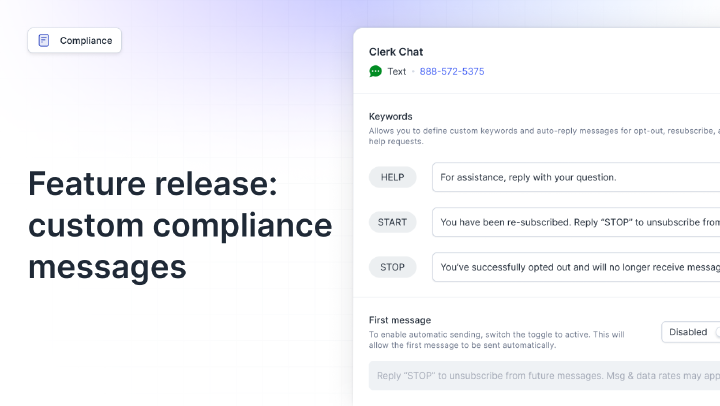Is Your Telephony Enough? Top 9 Google Voice Alternatives
By Team Clerk Chat
- Published: January 13, 2025
Looking for Google Voice alternatives to help turbocharge your business communications? We’ve got you covered. While Google Voice is a great all-around VoIP platform for companies that want a simple, low-cost way to make calls over the internet, it’s far from perfect.
For those with more advanced needs, Google’s VoIP solution is a little basic, lacking access to things like toll-free numbers, extensive integrations, and flexible global reach. Even SMS capabilities are limited, if you want to use SMS for marketing, sales, and customer service.
Fortunately, there are plenty of alternative options to explore. Here, we’re going to introduce you to some of the best platforms and apps like Google Voice you can consider using. Plus, we’ll be sharing our top tips for narrowing down your options, and making the right choice.
In this article:
The Best Google Voice Alternatives
Just like Google Voice, all of the best alternatives to the platform have their own unique strengths and weaknesses to consider. We’ve tried to create this list to include something for everyone – whether you’re budget-conscious, ready to invest in innovative new tools, or just looking for a user-friendly experience. Let’s dive in.
1. Clerk Chat: The Best Google Voice Alternative for SMS and AI
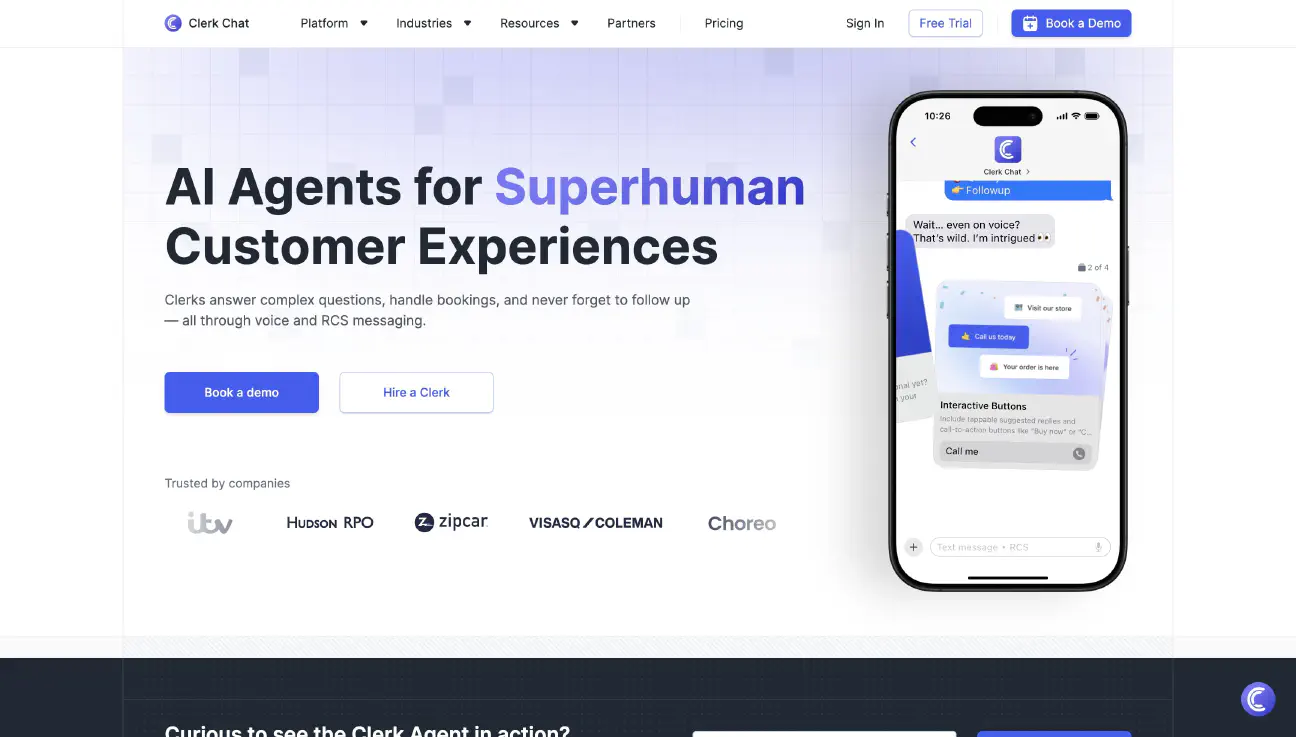
When it comes to comparing Clerk Chat vs Google Voice, the first thing you’re likely to notice is that Clerk Chat is far more robust from an SMS perspective. Clerk Chat doesn’t just give companies access to a comprehensive VoIP solution so they can make calls over the internet.
It’s also one of the best SMS marketing platforms around. With Clerk Chat, you’ll be able to create transactional and promotional text campaigns with convenient templates. You can automate and schedule texts to reach your customers at specific times. You can also engage in two-way conversations with anyone (from colleagues to customers) across the globe.
Clerk Chat supports omnichannel communication through voice, SMS, and messaging apps. Plus, it integrates directly with tools like Microsoft Teams and Zoom. On top of that, Clerk Chat offers additional phone numbers for a lower price than Google Voice, shared phone numbers, and comprehensive number porting capabilities.
You’ll even get access to cutting-edge AI in the Clerk Chat platform. For instance, you can use conversational AI SMS to connect with customers 24/7 and access AI analytics when diving into your calling metrics and KPIs.
Pricing: New users can sign up for a free trial of Clerk Chat, with bring-your-own-number functionality and support for 100 messages. Paid plans, with unlimited messages and 5000 contacts start at only $9.99 per month.
| Pros | Cons |
|---|---|
| • Advanced AI capabilities • Automated 10DLC registration • Support for various numbers and carriers • Integrations with business apps • User-friendly design • Affordable pricing structure • Excellent SMS capabilities • Global calling | • Heavier focus on SMS than voice • Limited messaging on free trial |
Looking for a Google Voice alternative that offers more power and flexibility? Clerk Chat delivers advanced features, integrations, and support. See how we compare!
Learn more2. 8x8: Excellent Security Features
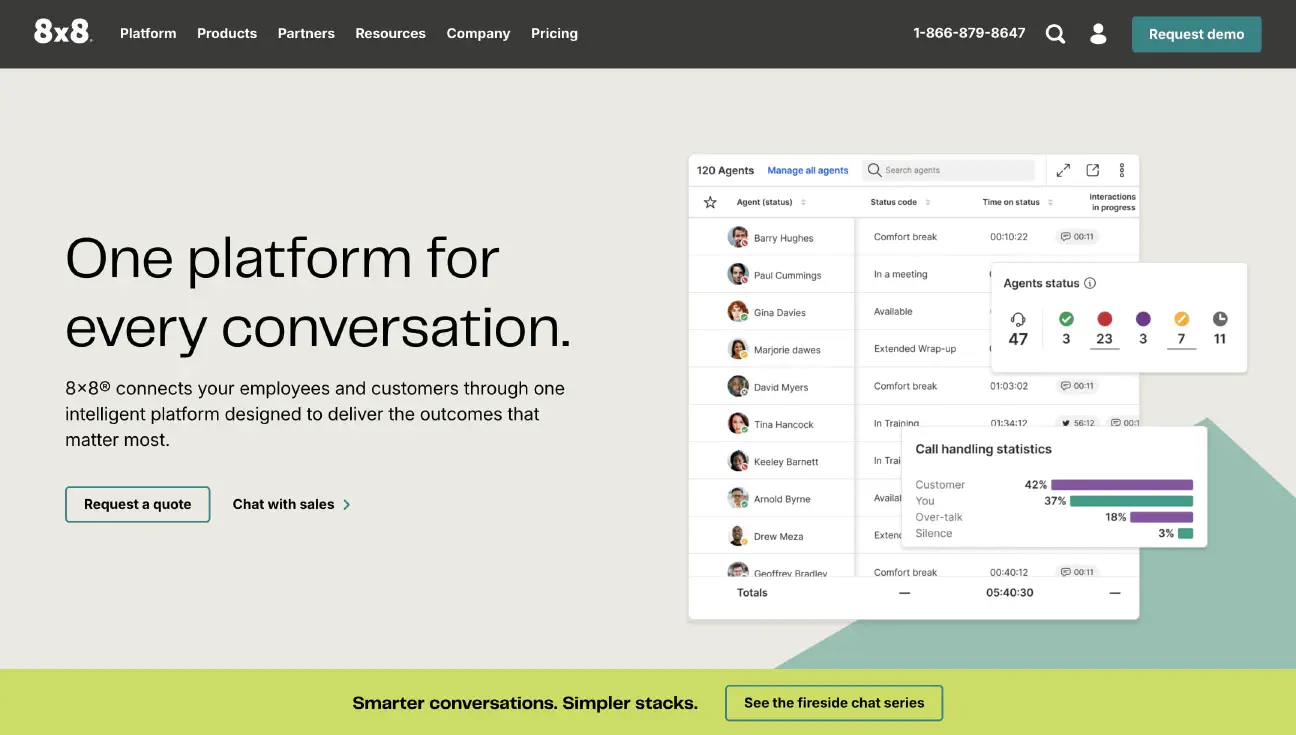
8x8 is one of the top communication software providers in the world, with a host of tools companies can use for internal collaboration, workforce management, and even AI customer service. What makes 8x8’s software so great is how flexible and scalable it is. You can experiment with a wide range of mix and match features for just about any use case.
Beyond giving users access to more features like call queues and local numbers, 8x8 also delivers exceptional security. If you’re worried about privacy and compliance, 8x8 supports everything from TLS/SRTP encryption to multi-factor authentication.
The company’s technology is also constantly evolving, with new features like AI-powered assistants, and workflow scheduling capabilities. Plus, you’ll be able to easily integrate 8x8 with many of the tools and platforms your company already uses, like Microsoft Teams. However, business messaging options (SMS) are somewhat limited.
Pricing: 8x8 doesn’t share any public pricing details on their website. However, in the past, standard VoIP plans started off at around $24 per month, depending on your needs. Some packages, which combine unified communication and contact center tools can cost a lot more.
| Pros | Cons |
|---|---|
| • Great outgoing call features • Fantastic integration options • Brilliant security capabilities • Lots of employee training features • Excellent onboarding assistance and customer support • Flexible add-on features | • More expensive pricing • Some issues with spam prevention |
3. Zoom Phone: Best Value for Money
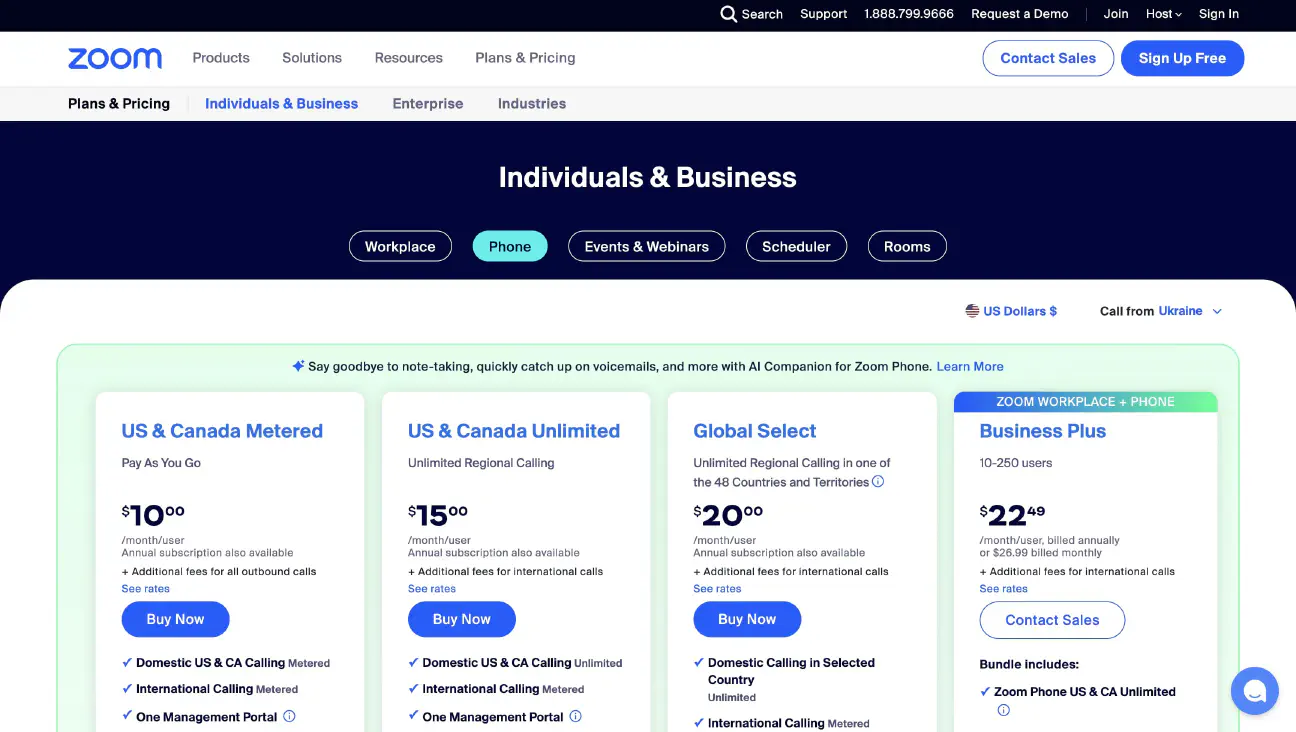
Zoom Phone is a simple, but effective option, similar to many Google Voice alternatives, that can scale to suit the needs of numerous companies. Not only does this platform integrate seamlessly with Zoom’s other collaboration tools (like Zoom Docs and Meetings), but it works well alongside a range of other business applications too.
For instance, with a Zoom SMS integration from Clerk Chat, you can embed all of the AI capabilities and comprehensive SMS marketing features of Clerk Chat into Zoom. Compared to Google Voice, Zoom is a much more scalable solution, with more advanced features, even on its basic plans.
Those basic plans are excellent value for money too, starting at as little as $10 per month per user – so if you want to make sure you’re keeping costs low, Zoom is a good choice. Plus, Zoom, like many other platforms, is constantly adding new features and capabilities. Recently, it significantly upgraded its security and encryption features, and added new AI Companion tools too.
Pricing: For metered plans on Zoom Phone, prices start at around $10 per user per month. The Unlimited plans, on the other hand, cost around $15 per user, per month, and the Global Select plan will cost around $20 per user per month. You can also choose to purchase Zoom Phone as part of a “Zoom One” subscription, which includes access to other Zoom tools.
| Pros | Cons |
|---|---|
| • Low prices for plans • Excellent tools for managing high numbers of incoming calls • Integrations with lots of Zoom and third-party apps • Excellent security features • Easy to use platform | • Basic customer support • Outbound calling features could be better |
4. RingCentral: Easy to Set Up and Use
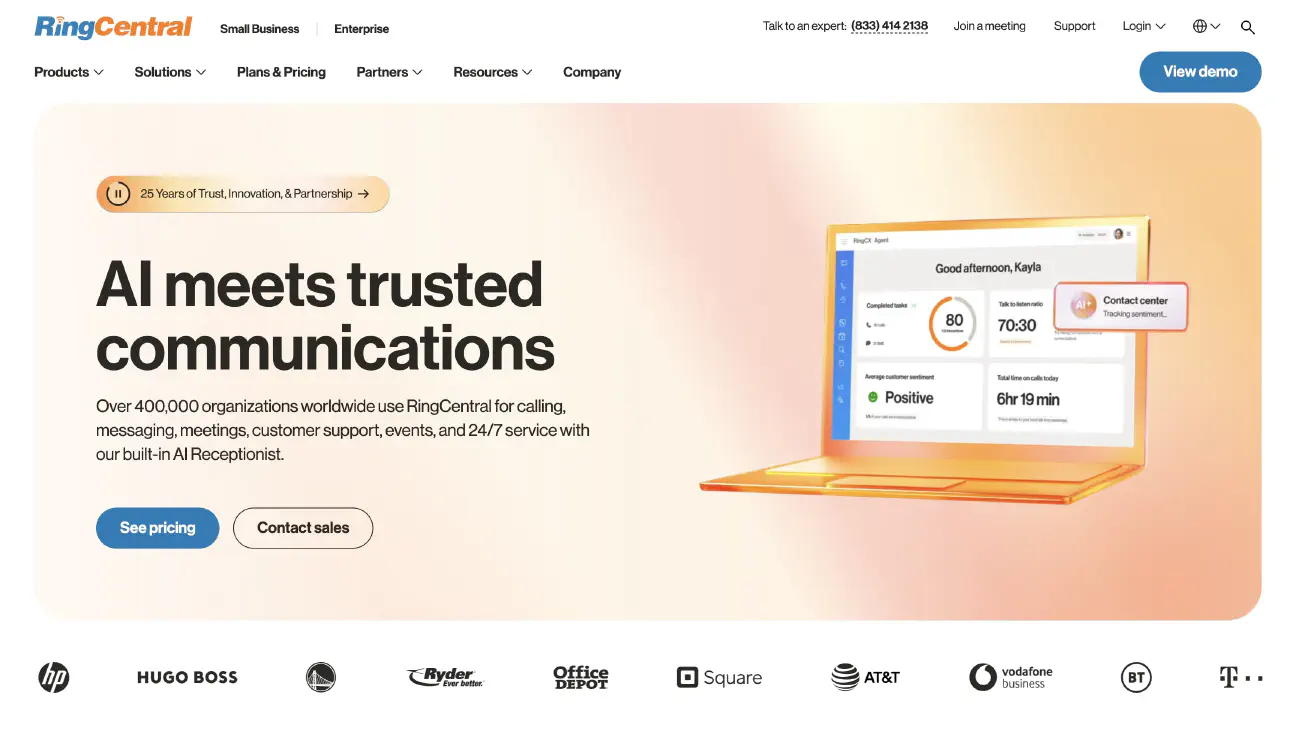
RingCentral is another great choice if you’re looking for reliable Google Voice alternatives. Although it lacks the robust SMS capabilities of some Google Voice and RingCentral alternatives, it is an omnichannel solution that supports SMS, voice, video conferencing, and messaging.
All RingCentral calling plans come with access to essential features that you might miss on Google Voice, such as toll-free numbers and call management tools. Plus, you still get unlimited calls within the US and Canada. On top of that, you’ll have access to a wide range of collaboration tools, such as team messaging and document sharing capabilities.
RingCentral is relatively easy to set up and use, too, making it great for businesses who don’t have a lot of time to invest in training. Although it’s worth noting there are some hidden fees and limitations to be aware of. For instance, RingCentral limits how long you can store conversations for compliance and data analysis purchases, unless you’re paying for higher-tier plans.
Pricing: Pricing plans start at around $20 per month for the Core VoIP package. The Advanced plan, with access to call recording, more texts per month, and app integrations starts at $25 per month, per user. Finally, there’s an Ultra plan for $35 per month per user, with additional features.
| Pros | Cons |
|---|---|
| • Highly scalable solution • Lots of integrations with additional tools • Easy set up and management • Omnichannel capabilities • Collaboration tools built-in • Reliable functionality | • Some feature limitations and hidden fees for certain tools • Limited SMS capabilities • Basic customer support |
5. Dialpad: Best for Contact Centers
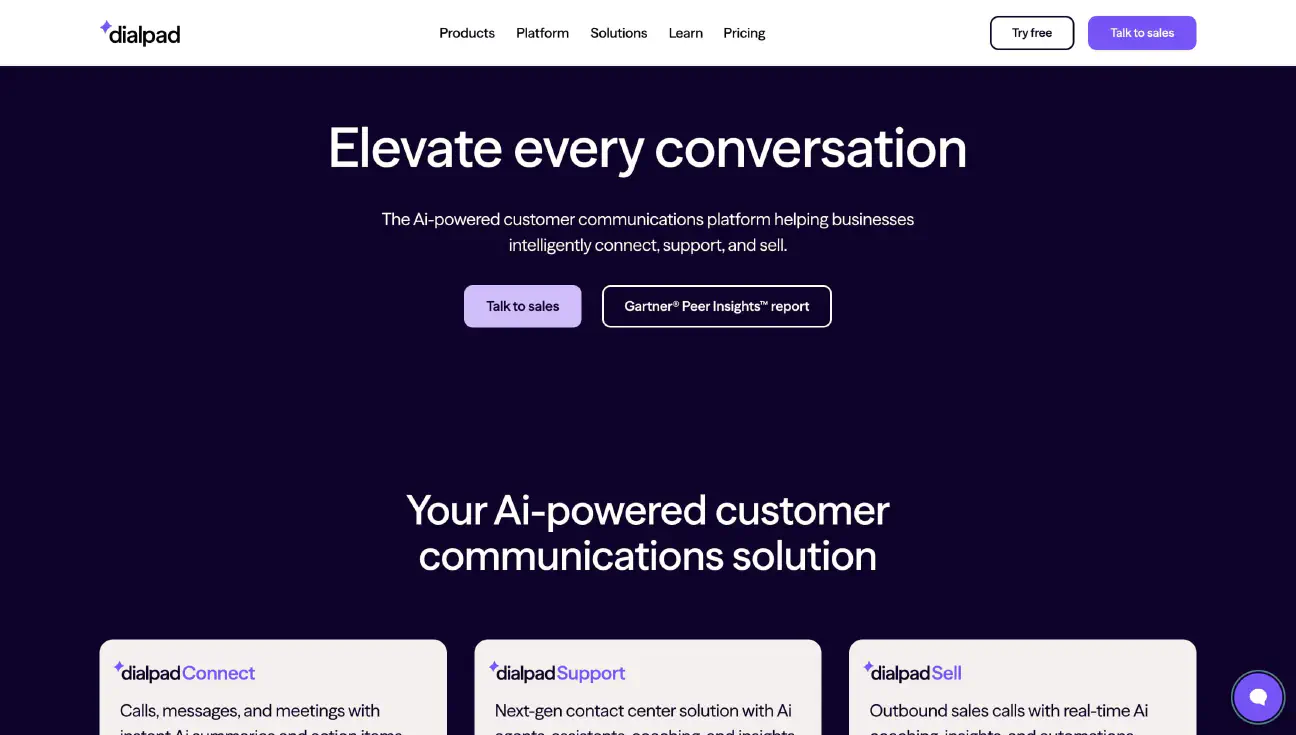
If your main gripe with Google Voice is that it’s not ideal for managing customer service operations, Dialpad could be the perfect alternative. This cloud communication platform comes packed with AI tools for customer support, including AI-powered chatbots and voice bots, and IVR systems. You can even access “agent assist” bots to support your team members.
Dialpad’s phone capabilities are reasonably strong, and you still get access to unlimited calling in the US and Canada (just like you would with Google Voice). Unfortunately, there are some lacking elements too, such as support for additional phone numbers and team segmentation.
There are a few issues with SMS functionality and integrations too. For instance, if you want to integrate your technology with tools outside of Microsoft 365 or Google Workspace, you’ll need a premium plan. You’ll struggle to access things like SMS for Microsoft Teams too. Still, Dialpad gets decent reviews for its customer service and ease of use.
Pricing: Plans start at around $15 for the Standard plan, with access to a range of AI tools. There’s a Pro plan for $25 per month that unlocks CRM integrations. Plus, you can contact the team for a dedicated quote for the “Enterprise plan.”
| Pros | Cons |
|---|---|
| • Unlimited US and Canada calling • Integrated AI tools • Easy to use interface • Integrations available on higher-tier plans • Decent reliability and up time • Great for customer support teams | • Additional numbers are more expensive • No international SMS on the base plan |
6. Ooma: Best for Customer Experience

Ooma combines a strong feature set with access to various integrations, and relatively cost-effective pricing packages. As one of the top Google Voice alternatives, it supports virtual receptionists, overhead paging, and unlimited voice calls in the US, Canada, Mexico and Puerto Rico.
Ooma also includes video conferencing capabilities to help your teams collaborate, and can integrate with a wide range of CRM platforms like Salesforce and Zendesk. Ooma is missing a few advanced capabilities though. It’s not the top company for AI in telecom functions and lacks robust SMS capabilities. On the plus side, local and toll-free numbers are available – in the US.
Plus, you’ll be able to set up and start using the platform pretty quickly, as the overall interface is clean and easy to use. The customer support options are a lot better too, with 24/7 live chat and phone support and extensive onboarding assistance.
Pricing: Ooma Office plans start at $19.95 for the Essentials plan, which comes with a wide range of features, including a virtual receptionist. The Pro plan costs $24.95 per month, and gives you higher usage limits for audio conferencing and extension monitoring. There’s also a Pro Plus plan for $29.95 per month, which enables additional integrations and advanced call management.
| Pros | Cons |
|---|---|
| • Free number transfer for beginners • Free calling across the US, Canada, Mexico and Puerto Rico • Excellent customer support • Easy set up and management • Multi-level virtual assistants • Local and toll-free numbers in the US | • SMS only available on higher tiers • Limited security features • Fewer third-party integrations than some alternatives |
7. OpenPhone: Best for Smaller Businesses
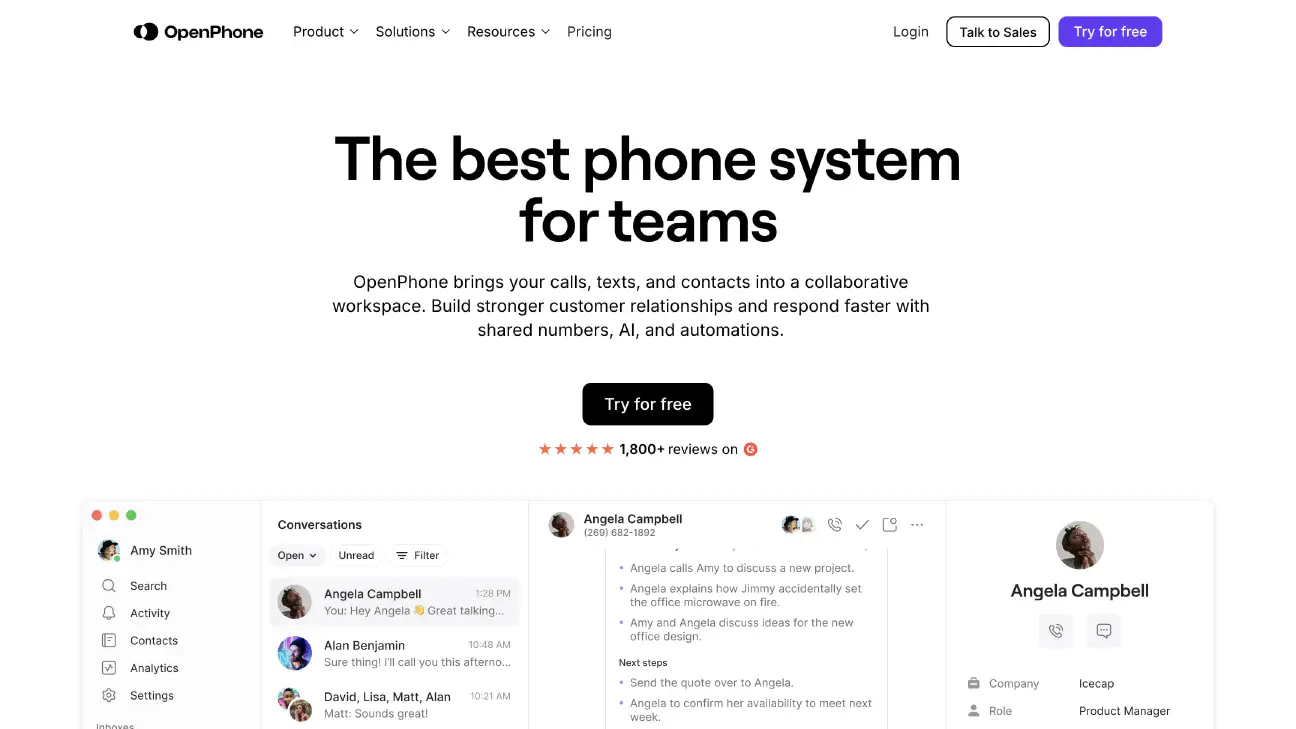
If you’re looking for Google Voice alternatives that are equally well-tuned to the needs of smaller companies, OpenPhone is a good pick. Not only is OpenPhone extremely affordable (though it’s not quite as cheap as Google Voice), but it makes it easy to port your existing number into the platform for free. Plus, the SMS capabilities are better too.
Although you still won’t get the advanced tools you can use to create promotional and transactional text messages you’d get from Clerk Chat from OpenPhone, there are some bonus extras. For instance, you can use conversational AI for customer service auto-response messages.
OpenPhone is also relatively scalable, with integrations for more than 5,000 other platforms through Zapier. However, it’s worth noting that Zapier integrations aren’t quite as convenient as the one-click integrations you get from other OpenPhone alternative providers.
Pricing: OpenPhone offers a range of plans to choose from, starting with Standard for $15 per user per month. The Premium plan costs $23 per user per month, and the Enterprise plan comes with a custom quote based on your specific needs.
| Pros | Cons |
|---|---|
| • Unlimited calling and texting for the US and Canada • Vanity, toll-free, shared, and local numbers available • Lots of integrations through Zapier • AI-powered tools for texts, summaries, and call transcriptions • Easy to use platform | • Some limitations with customer support • Lacking some advanced features • Not the best at spam prevention |
8. Grasshopper: Best for Freelancers and Solo Users
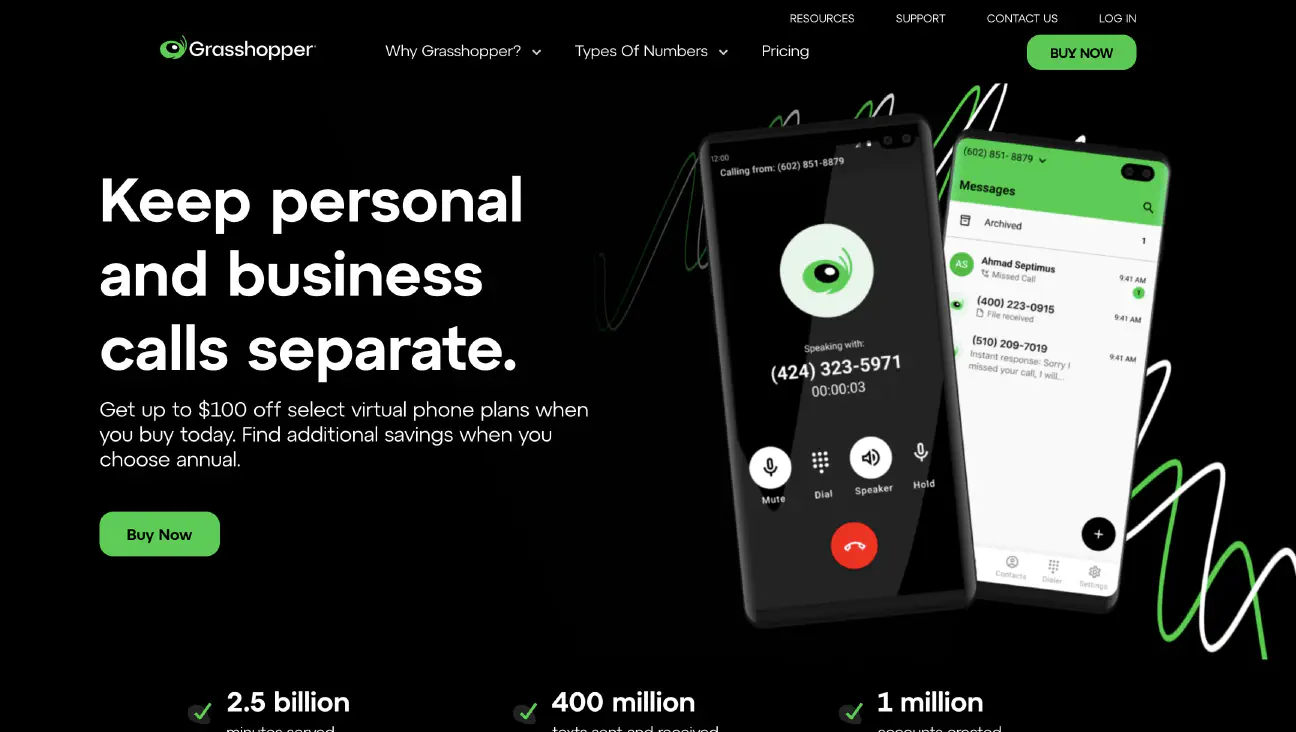
Compared to some of the other Google Voice alternatives on this list, Grasshopper isn’t as well-known. However, it’s still a respectable option, depending on your needs. First, the platform offers access to local and toll-free numbers, and allows companies to add unlimited users to two of its plans – which makes it a bit more flexible than Google Voice.
Unfortunately, Grasshopper isn’t really built for collaboration, as there are no shared phone numbers, and no built-in conferencing tools. You also don’t get access to a lot of integrations, or call recording capabilities. Still, on the basic, Solo tier, you will get advanced reporting and ring groups, which are reserved for more expensive Google Voice plans.
Higher tiers give you access to more phone numbers and extensions too. Plus, you get a useful auto-attendant phone menu with multi-digit extension options. Although, notably, there’s no real SMS functionality, so if you want to access landline text messages and other features, you’re out of luck.
Pricing: Grasshopper’s plans are reasonably competitive, although they’re not the cheapest we’ve seen. The True Solo plan starts at $14 per month. Solo Plus will start at $25 per month with unlimited users, one number, and three extensions. Finally, the small business plan starts at $55 per month for four numbers and unlimited extensions.
| Pros | Cons |
|---|---|
| • Unlimited US and Canada Calling • Relatively attractive pricing • 24/7 customer support on all plans • Easy-to-use VoIP system • Handy auto-attendant capabilities • Good quality basic plan | • No call recording or shared numbers • Limited integrations • Few advanced features |
9. Nextiva: Best for Professional Services Teams

Similar to Ooma, Nextiva is a popular and well-known VoIP company. The company offers organizations a pretty decent choice if they’re looking for an alternative to Google Voice with more functionality. For instance, you’ll gain access to virtual receptionists and customizable greetings with Nextiva, which aren’t available for Google Voice.
Probably what stands out most about Nextiva is its brilliant selection of analytical tools. You get plenty of reports and insights you can use to learn more about the kinds of calls your company is having, and the customer service you’re delivering. Nextiva is a particularly popular choice for companies in the professional services industry.
Nextiva is also very easy for users to get started with, and the company does offer 24/7 live support to all customers, so you’ll never have trouble getting assistance with an issue. On the other hand, there aren’t a lot of management features on this platform, and security features are limited. Plus, there aren’t any features for things like landline texting for business users.
Pricing: Nextiva’s Essential pricing plan starts at around $23.95 per user per month, but costs drop as you add users, costing around $18.95 for teams with more than 20 employees. There’s a Professional Tier starting at $27.95 per user per month, and an Enterprise tier starting at $37.95 per user per month. Both of these tiers come with slightly lower prices (per user) for additional team members too.
| Pros | Cons |
|---|---|
| • Support for unlimited users on all plans • Easy to use platform with a simple set-up • Lots of collaboration features included • Excellent analytical and reporting tools • 24/7 live support on all plans • Decent security features | • Limited call management features • No multi-factor authentication • Few integration options |
The Pros and Cons of Google Voice
When you’re running a small business, or working as a freelancer, using Google Voice for calling (and basic SMS), makes a lot of sense. It’s definitely an affordable option, with free calls available for the US and Canada, and it includes access to various features.
You can tap into call forwarding, ring groups, multi-level IVR systems, voicemail, and even two-way text messaging. Here’s a quick look at the pros of Google Voice:
- Free calls available for the US and Canada (inbound and outbound)
- Integrated ring groups, call forwarding, voicemail, and SMS
- Easy functionality for calling and sending texts from computers
- Seamless integration to Google Workspace products
- Low pricing options for some businesses
- Relatively straightforward platform
Looking for a Google Voice alternative that offers more power and flexibility? Clerk Chat delivers advanced features, integrations, and support. See how we compare!
Learn moreWhy Consider Google Voice Alternatives?
So, if Google Voice is such a straightforward option, why consider alternatives? Ultimately, Google Voice lacks a lot of the functionality certain businesses will need from their calling platform. Some of the main reasons you might look for an alternative to Google Voice include:
- Basic call management tools: Although Google Voice offers basic call management tools, it lacks some of the essentials, like shared numbers, auto-reply options, call queuing capabilities, and even call routing (making it harder to separate departments).
- Limited global reach: Google Voice is primarily designed for US-based companies. Outisde of the US, you can’t sign up for the free version of the platform. There’s also no support for SMS features outside of the US.
- Basic SMS capabilities: If you’re using SMS for customer service, marketing, or sales, Google Voice lacks a lot of features – even for US users. You can’t access AI for texting, create automatic campaigns, or schedule texts, for instance.
- Limited integrations: Although Google Voice works brilliantly with existing Google apps, it’s not the best if you want to use your phone system alongside a wide range of third-party tools, like your SMS CRM system or workforce management apps.
- Poor customer support: Google doesn’t offer a lot of direct support for Google Voice, so if you have any issues with poor call quality or technical issues, you might struggle.
- Basic analytics and data: Google Voice gives you a very basic overview of your calling data and analytics. Other alternative platforms generally offer access to more in-depth reports, as well as real-time dashboards and monitoring tools.
- Sub-par collaboration tools: The only way to collaborate with your team while using Google Voice is through an integration with something like Google Workspace. There aren’t a lot of built-in features specifically for teams.
How to Choose the Right Alternative to Google Voice
So, how do you choose from all of the various Google Voice alternatives offering similar functionality and plans? Ultimately, making the right decision comes down to considering your company’s specific priorities. When we created this list of potential alternatives to consider, the main things we looked at included:
- Advanced features: The ideal Google Voice alternative should be able to do everything Google Voice can do – and then some. Look for advanced features like conversational AI assistants, intelligent workflow builders, advanced analytics, and reporting tools.
- Ease of use: The simplicity of Google Voice is one of its biggest selling points. The right alternative should be just as easy to use and convenient for your teams. Look for something that’s easy to set-up, customize, and learn how to use.
- Reach: Since Google Voice is limited for users outside of the US, you might want to consider looking for a solution that offers more enterprise text messaging and calling features for global organizations.
- Pricing: It might be difficult to find an alternative to Google Voice that’s equally as affordable, but your chosen platform should still match your budget. Remember to consider the “total cost of ownership” and the value you’re getting for the price.
- Customer support: Lack of advanced customer support is a real downside for Google Voice. Try to find a company that offers more support with everything from setting up new numbers, to handling integrations, and resolving technical issues.
- Integrations: Ideally, your VoIP or business calling solution should be able to work alongside the tools you’re already using. Look for easy integrations with CRM platforms, collaboration software, and archiving tools.
A Flexible, Low-Cost Google Voice Alternative
While all of the Google Voice alternatives mentioned above have something special to offer, Clerk Chat stands out as one of the most flexible, low-cost alternatives, particularly for those who want to combine voice capabilities with SMS and messaging.
Not only does Clerk Chat give companies access to a wide range of SMS-based tools, texting templates, and automation options, but it supports various number and communication channels too. It’s also packed with powerful AI capabilities, like the Clerk Chat Assistant that can send a message from your computer to your customers for you at any time of the day or night.
Clerk Chat also integrates seamlessly with all of the tools companies already use, from CRM platforms, to workforce management tools, archiving applications, and collaboration tools like Microsoft Teams. With its user-friendly design, affordable pricing, and scalability, Clerk Chat is the ideal option for any company trying to take their communication strategy to the next level.
Learn more about what Clerk Chat can do for your business and find out how it compares to Google Voice.
In this article:
Ready to use your business number for text messaging?
Thousands of businesses are already experiencing the power of conversational messaging through SMS. Join us. Free trial and paid tiers available.
Get Started#Subscribe
Get product updates in your inbox
Tutorials, features, and Clerk Chat news delivered straight to you.



